Introduction
In the research study by Dolgov and Durfee (2006), the resource allocation problem (RAP) is described as being the allocation process of the available resources to the clients (scheduled tasks or agents, either cooperative or self-interested) in a way which maximizes the global utility. As an optimization problem, RAP is a multi-objective and over-constrained problem. Even if the optimality is rarely needed in the real-world situations, the optimal solution is expected by the users. For solving RAP, a centralized or distributed approach could be undertaken. Ridder et al. (2012) mentioned that a distributed constraint optimization problem (DCOP) is more adequate in a large problem space. In this case, the problem is split into agents, each of them having a specific set of variables and constraints as well as local optimization criterion. The goal is to find a feasible solution with the highest ranking by all agents.
Developing academic class timetable is a real-world RAP. This problem involves the allocation of students, teachers and rooms, within certain restrictions (related to the regulations, proper utilization of resources, and satisfaction of people’s preferences), for executing education activities in specific time-slots. Effective timetables for academic courses delivery are crucial for the efficient utilization of university resources and for ensuring the student satisfaction. Timetable is usually developed manually, based on valid solutions applied in the previous years. This approach does not even guarantee finding an optimal solution, even a valid one. Silvia et al. (2004) suggested that the problem complexity is increasing when multiple criteria and types of classes are considered. Computational intelligence methods are successfully applied to solve the academic class timetable problem. The earlier works on the class timetabling problem, using neural network, are found in (Gislen et al., 1992) and (Looi, 1992). Carrasco and Pato (2004) define two neural network architectures to solve the timetable problem, one based on continuous potts neurons and the other on discrete winner-take-all neurons. A constraint solver is defined by Rudova and Murry (2003) for developing a demand-driven academic timetable. It allows the hard constraint propagation together with the preference propagation for the soft constraints.
Multi-Agent Systems and Agent-Based Methodologies
Bodea et. al. (2011) agree that the multi-agent system (in short, MAS) represents an important paradigm in the field of distributed computation. Promoting the collaborative approach in complex problem solving, MAS is a natural implementation of the distributed constraint optimization (DCOP) approach. When MAS is adopted, a collaborative planning and participatory environment in decision making can be applied, allowing the involvement and participation of multiple experts and stakeholders (Mendoza and Prabhu, 2003). The MAS is composed by several agents that communicate and work together in an environment (application field or problem). Each of these agents is designed to have a goal. According to this goal it will act in a specific way and at a specific moment of time. For obtaining resources, the agent’s utility should be calculated. The utility is usually defined by what the agent can achieve using these resources, which is a non-trivial task, because the agent’s actions might have long-term and nondeterministic effects and they are conditioned by the resources it will obtain. This leads to cyclic dependencies, with no possibility to calculate parameterized solutions. Determining classes of utility functions (deVries & Vohra, 2003), iterative algorithms for resource allocation, preference elicitation (Sandholm & Boutilier, 2006), and concise languages for expressing agents’ preferences (Boutilier, 2002) there are only some solutions for addressing this issue.
Implementing MAS is a complex and laborious process and the role of the applied methodology is essential. For this reason, a lot of research is done in the agent-oriented methodologies field, revealing that methodologies are even more important in developing MAS than in another software engineering projects (Brinkkemper, 1996), (IEEE Standards Board, 1990), (Sturm, Shehory, 2003). Agent-based methodologies consider the enterprise as divided into sub-organizations where agents play one or more roles, interacting with each other. Concepts as “role”, “social dependence” and”organizational rules” are used not only to model the system environment, but also to model the system itself. One of the most important aspects addressed by an ABM is the description of interactions between agents, simulating thedependencies between agents and their roles in the system. Each methodology must have a high enough degree ofabstraction in agent modeling. This is why the object-oriented methodologies are not suitable for developing multi-agent systems. An agent-oriented methodology should be in focused on agents, the roles they have made in systems andinteraction protocols.
A Multi-Agent System Development for Resources Allocation in Universities
Let’s consider that the resources allocation is made based on a predefined set of criteria, which have to be fulfilled in order to allocate the resources. How better the criteria must be fulfilled is interactively decided during a negotiation process. If the expectation level of the client (programme/course) is too high, it is a high risk to not be able to allocate resources. Contrary, if the expectations are too low, the risk is to get low quality resources. This is why, a negotiation process, running several negotiation rounds is a better solution than other approaches. The figure 1 presents the criteria for the resource Professors.

Fig. 1. The Allocation Criteria for Professors
The criteria applied in the negotiation process for acquiring the “professor” resources are teaching experience (in the university and in the programme/course topic), academic evaluation (the results of the evaluation made by the students and by the peers), and the scientific activity (scientific papers, research projects, member of the professional associations, reviewer at scientific journals and conference). All these criteria are used for implementing soft constraints in the timetable engine, as preferences of programmes/courses in terms of resources (professors and teaching rooms). We assume that the resource inquirers are weakly-coupled, meaning that the programmes/courses only interact through the shared resources, and once the resources are allocated, their state transitions are independent. While this allocation assumption introduce a limitation in our approach, it also allows us to address more efficient the non-cooperative situations and to avoid the state space explosion.
The methodology applied for the development of the system is TROPOS. According to TROPOS, the following development phases have to be executed, sequential and iterative: the requirement analysis, the system description in relationship with the operational environment, the design of overall architecture, the design of detailed architecture and the system implementation.
The Requirements Analysis
The environment of the system contains the following entities (figure 2):
- Inquirers, asking for resources and representing different programmes/courses ;
- Resource managers, owning the resources in the university (heads of department/char);
- Resources (professors and rooms for didactical activities)
- Negotiator, the entity proposed by the organization to find solution for a good utilization of the resources. We consider that the negotiator is representing the organization interest for a better utilization of the resources.
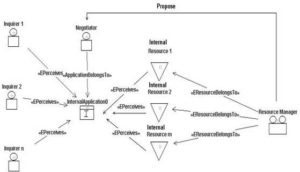
Fig. 2. Environment Diagram
The System Description in Relationship with the Operational Environment
Figure 3 presents, in hierarchical form, the goals of the participants in the resource allocation process.

Fig. 3. The Multi-Agent System Goal Tree
The Design of Overall Architecture
The overall architecture is defined in term of sub-systems, relationships and dependences. Figure 4 presents the model of roles and agents. The correspondences between agents and roles are presented in Table 1.
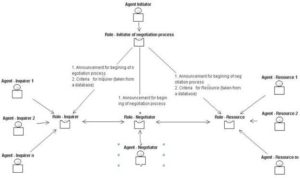
Fig. 4. The Roles and Agents Model
Table 1. The Correspondences between Agents and Roles
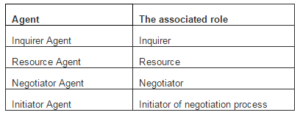
The overall architecture of the UNIRA system is presented in figure 5. The exchange of messages between agents is presented in Table 2.
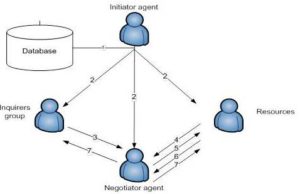
Fig. 5. The Overall Architecture of the UNIRA System
Table 2. The Message Exchange
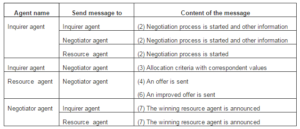
The Design of Detailed Architecture
Due to their ability to model dynamic systems, the object-oriented Petri nets are chosen to define the multi-agent system detailed architecture. The detailed architecture contains the main components (agents), the interconnections between components, and the inputs and outputs for each of them. To get clarity, the agency is represented only by inputs, outputs and a generic transaction including all places and transitions. Figure 6 presents a multi-agent architecture based on object-oriented Petri net and figure 7 presents the detailed architecture of the system.
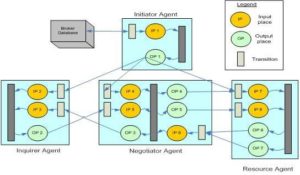
Fig. 6. The Architecture Based on Object-Oriented Petri Nets
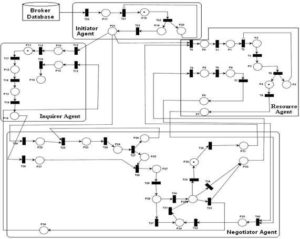
Fig. 7. The Detailed Architecture of the System
The negotiation agent, using the information sent by the Inquirer agents create an AHP tree, which is be used for the scores calculation, for each offer issued by resource agents.
System Validation
The system validation starts with the most important characteristics of the system, assuring the approach originality. The originality of the system relies mainly on the negotiation process, executed in a very transparent way. In order to validate the user satisfaction in using the system, a questionnaire was designed and applied to 50 persons, representing 25applicants, 20 resource managers, and 5 negotiators. The questionnaire has the following questions: how intuitive is theinterface of youragent (1 – very little intuitive, 5 – very intuitive); have you identified factors which you considerunnecessary for the interface? (1-No, 0-Yes) (max: 25); did you experience difficulties in the execution? (1-No, 0-Yes); you needed advanced knowledge in order to work with the application? (1-No, 0-Yes); did you experience errors in the communication with the server? (1-No, 0-Yes); how do you rate the quality of the allocated resources in relation to yourrequest? (1-totally inadequate, 5 – totallyappropriate) — only for the Inquirer agent ; how do you consider the rankingposition that you have placed (1-completely unacceptable, 5 – total acceptable) — only for the resource agent and how do you rate the communication with other entities? — only for the negotiator Agent.
The degree of interface understanding (the question one) is lower to the applicants (only 84%), because the gradingcriteria are made by comparison (the elements belonging to the same leaf node are evaluated comparing them to allothers). This approach produces confusion for the users working for the first time with the application. The resourcemanagers get a higher score (around 90%), mainly because the values for the resource evaluation are directly input in the system. The negotiators consider that the interface as intuitive, getting a score around 92%. The reason for not getting a higher sore is the data aggregation and calculations, a lot of the intermediary results being shown on the negotiationinterface. At second question, about 70% of the negotiators consider that some information, mainly the intermediary results may be removed from the interface. At question three, only 2 out of 5 negotiators, 9 out of 20 resource managers, and 19 out of 25 inquirers declare that they experienced difficulties during the usage of the system. At question four, regarding the level of knowledge required for the system usage, 80% of the users declare that they do not need prior knowledge about the system. The question five is addressing the most common problem, the communication with the server. Only 21 out of 50 persons did not experience communication problems. Regarding the question 6.1, 60% of inquirers are satisfied with the allocation result, considering that the allocated resources meet the requirements. Atquestion 6.2, 85% of the resource managers consider the negotiation results as acceptable. At question 7, thecommunication problems for the negotiators are more frequent than other entities. This is because the negotiator sends and receives the largest amount of information in the system.
Conclusions and Future Work
The paper presents a model based on MASs for solving the problem of allocating resources in an academic environment. The novelty of the system is that it applies the negotiation process for incremental satisfying of the soft constraints, in a transparent way (the intermediate results are sent to all participants and their preferences might change accordingly). This approach reduces the computational complexity of the resources allocation problem. The model is relevant not exclusively for the academic resources management, but also for a large variety of domains, including the load distribution, production planning, computer scheduling, portfolio selection, apportionment, and so on.
The system limitation is that, for the moment, it is a stand-alone system, not being integrated into the ERP system of the university. In the near future, the authors will integrate system in the ERP system, in order to generate the academic timetables and different reports about the resources management.
References
Bodea, C. N., Badea, I. R. & Purnus, A. (2011). “Distributed Research Project Scheduling based on Multi-Agent Methods,” in: Journal of Applied Computer Science & Mathematics, no. 10 (5) /2011, pag. 20-26, ISSN:1843-1046, Suceava, http://www.jacs.usv.ro/?pag=info.
Publisher – Google Scholar
Boutilier, C. (2002). “Solving Concisely Expressed Combinatorial Auction Problems,” In Proceedings of the Eighteenth National Conference on Artificial Intelligence (AAAI-02), Pp. 359—366.
Publisher – Google Scholar – British Library Direct
Brett, S. W., Ridder, J. P. & Signori, D. T. (2012). Distributed Algorithms for Resource Allocation Problems, The 17th International Command and Control Research and Technology Symposium, 19-21 June, Fairfax VA USA.
Publisher
Brinkkemper, S. (1996). “Method Engineering: Engineering of Information Systems Development Methods and Tools,”Information & Software Technology, 38, Pp. 275-280.
Publisher – Google Scholar
Carrasco, M. P. & Pato, M. V. (2004). “A Comparison of Discrete and Continuous Neural Network Approaches to Solve the Class/Teacher Timetabling Problem,” European Journal of Operational Research 153 (1), 65—79.
Publisher – Google Scholar
De Vries, S. & Vohra, R. V. (2003). “Combinatorial Auctions: A Survey,” INFORMS Journal on Computing, 15(3), 284—309.
Publisher – Google Scholar – British Library Direct
Dolgov, D. A. & Durfee, E. H. (2006). “Resource Allocation among Agents with MDP-Induced Preferences,” Journal of Artificial Intelligence Research 27, 505—549.
Publisher – Google Scholar
Gislen, L., Peterson, C. & Soderberg, B. (1992). “Complex Scheduling with Potts Neural Networks,” Neural Computation4, 805—831.
Publisher – Google Scholar – British Library Direct
IEEE Standards Board (1990). ‘Standards Coordinating Committee of the Computer Society of the IEEE,’ IEEE Standard Glossary of Software Engineering Terminology, IEEE.
Looi, C. K. (1992). “Neural Network Methods in Combinatorial Optimization,” Computers and Operations Research 19 (3/4), 191—208.
Publisher – Google Scholar
Mendoza, G. A. & Prabhu, R. (2003). “Qualitative Multi-Criteria Approaches to Assessing Indicators of Sustainable Forest Resource Management,” Forest Ecol. Manage. 174, 329—343.
Publisher – Google Scholar
Rudova, H. & Murry, K. (2003). “University Course Timetabling with Soft Constraints,” In: Burke E. K. and Causmaecker P. D. (Eds.), Proceedings of the Practice and Theory of Automated Timetabling IV, Fourth International Conference, Gent, Belgium, Lecture Notes in Computer Science (LNCS), Springer, Pp. 310—328.
Publisher – Google Scholar – British Library Direct
Sandholm, T. & Boutilier, C. (2006). Preference Elicitation in Combinatorial Auctions. In: Cramton, Shoham, & Steinberg (Eds.), Combinatorial Auctions, MIT Press.
Publisher – Google Scholar
Silva, J. D. L., Burke, E. K. & Petrovic, S. (2004). “An Introduction to Multiobjective Metaheuristics for Scheduling and Timetabling,” Lecture Notes in Economics and Mathematical Systems, Springer, Volume 535, Pp. 91—129.
Publisher – Google Scholar – British Library Direct
Sturm, A. & Shehory, O. (2003). A Framework for Evaluating Agent-Oriented Methodologies, În Giorgini P. and Winikoff M. (Eds.), Proceedings of the Fifth International Bi-Conference Workshop on Agent-Oriented Information Systems, Melbourne, Australia, Pag. 60-67.
Publisher – Google Scholar











